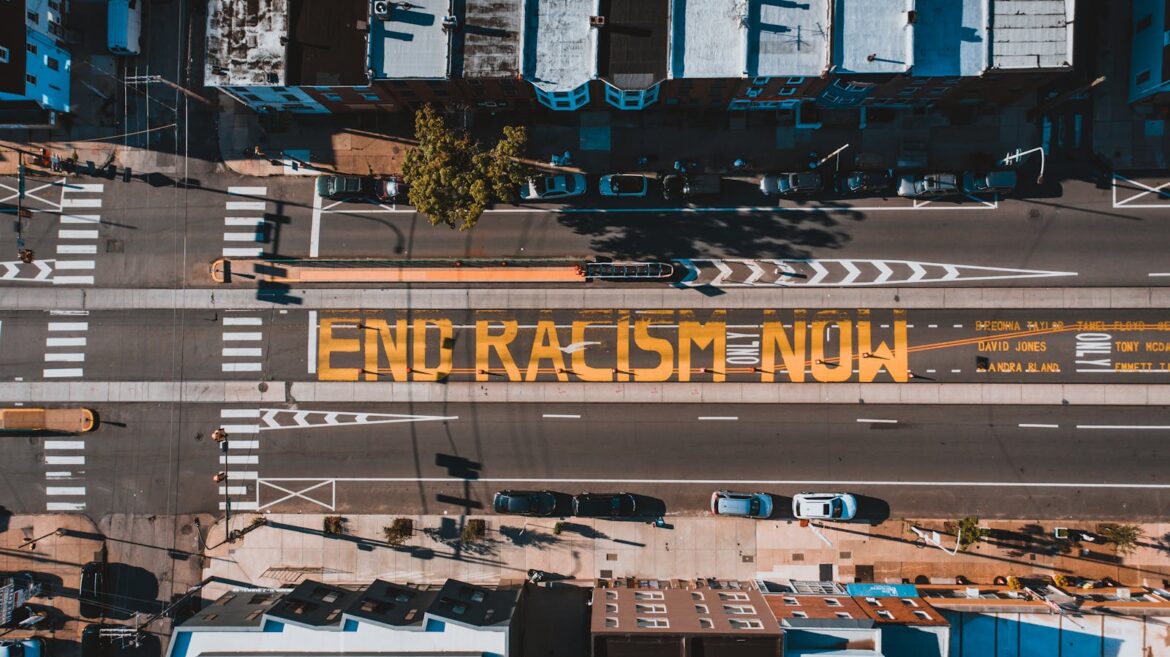Uno de los temas mas discutido en los medios de comunicación es el racismo sistémico, y cómo afecta a la gente de color, incluyendo a los Hispanos, como yo.
He tenido la oportunidad de viajar a varios países alrededor del mundo. He estado en Norte y Sur América, Europa, el Medio Oriente, los Emiratos Árabes unidos y la India.
Voy a comenzar con mis experiencias personales relacionadas con el racismo sistémico en estos países, como una persona de origen hispano. A continuación, voy a analizar el racismo sistémico en las diferentes instituciones.
Experiencia Personal con el Racismo Sistémico en Europa.
Nunca he experimentado racismo sistémico cuando he viajado a Canadá, los Estados Unidos, o los diferentes países que he visitado en Europa. Países que tradicionalmente estan constituidos por poblaciones blancas.
Estudié un semestre en el reino unido. La mayoría de mis compañeras de clase eran de tez blanca. Todas eran bonitas, bien vestidas, y se veía como Barbies en mi opinion. Siempre fueron amables conmigo.
Tengo que admitir que cuando vi a mis compañeras de clase por primera vez, pensé que me discriminarian porque yo no era blanca como ellas. Me di cuenta de que tenia esta idea preconcebida de lo que iba a ser discriminada porque yo era de México y me veo como tal.
Cai en la cuenta de que esta preconcepcion no era correcta. Pero ¿de dónde surgió esta idea en mi cabeza? Es entonces cuando me di cuenta de que los medios de comunicación habían influido en mí conduciendo a estas conclusiones. La realidad es que la gente blanca no es racista, sólo porque son de tez blanca.
Años más tarde, tuve la oportunidad de estudiar otro otono en España. Esta vez la discriminacion ni siquiera paso por mi mente. No fue un problema en absoluto.
También he viajado a otros países Europeos, como Francia, Los países Bajos, la República Checa, Suiza, Liechtenstein, Bélgica, Italia y Grecia.
En ninguno de estos países, experimente racismo sistémico. Ni en los lugares donde estudié, ni en el transporte público ni en las instituciones de gobierno si es que visite alguna en mis viajes.
La única queja que tengo, es que al viajar de un país Europeo a otro, un empleado en una aerolínea me preguntó si yo tenía una visa antes de abordar mi avión. Fue un poco frustrante porque los Mexicanos no necesitan visa para viajar alrededor de la mayoría de los países Europeos.
Asumir que porque soy Mexicana yo necesitaba una visa sin investigar primero fue algo molesto. Este incidente está relacionado con mi nacionalidad, no con mi raza, así que no lo considero como racismo sistémico.
Experiencia Personal con el racismo sistémico en los Estados Unidos
Algunos años más tarde, tuve la oportunidad de mudarme a los Estados Unidos en 2019. Yo vivo en un estado republicano, conservador de mayoria blanca, lleno de partidarios de Trump.
Los Hispanos y los negros no son muchos en la comunidad en la que vivo. Mi colonia, la gente de la iglesia, mis compañeros de trabajo, mis amigos, y la familia de mi esposo son mayormente de tez blanca.
En los 5 años en los que he estado viviendo en los Estados Unidos, nadie dentro de los círculos en los que me muevo ha sido racista a mí o me ha rechazado porque soy de origen Hispano, o inmigrante.
En mi primer trabajo aquí en los Estados Unidos, yo ganaba más dinero en un trabajo de medio tiempo, que esposo de tez blanca, que ha vivido aquí toda su vida y con un trabajo de tiempo completo. Esto fue debido a mi carrera, experiencia, cualificaciones y el tipo de trabajo que yo realizaba.
Mi experiencia ha sido muy positiva y yo no podía estar más satisfecha. Basado en lo que he vivido, yo diría que no existe el racismo sistémico. Al menos en donde yo vivo.
Interacciones con personas racistas en los Estados Unidos
El hecho de que yo no haya experimentado racismo sistémico, no significa que no existan las personas racista.
Han habido dos experiencias donde me he encontrado con gente racista. Fue en el trabajo, pero no se trababa de mis compañeros de trabajo o superiores. Fueron mis clientes quienes me trataron de forma racista.
Ambos eran de tez blanca, de mediana edad, más probable orientados hacia la izquierda en el espectro político. En su defensa, ambos eran muy agradables y bien intencionados, y no creo que se dieran cuenta de cómo sus comentarios estaban siendo racistas.
En el primer caso, el hombre al que estaba tratando de ayudar estaba viendo un video sobre Trump al final de su primera administración. Él muy enojado, dijo: "yo quiero que él se vaya lo más pronto posible", en referencia a Trump asumiendo que yo estaría de acuerdo con él.
Yo quería dejar la política fuera de mi trabajo y no me gusta mentir, así que respondi de la manera más neutral, posible. "Él no va a ir a ninguna parte hasta que fallezca", respondí. Esto es algo que considero cierto y una respuesta que considere lo que iba a satisfacer.
¿Por qué esta interacción es considerada racista?
Yo soy de origen Hispano, y me veo como tal. El hecho de que haya asumido mi orientación política sólo por la forma en la que me veo es racista. La creencia de que debo votar, apoyar, o pensar de una manera determinada por la forma en la que me veo, como he dicho anteriormente es racista. Pero yo no creo que él era consciente de que esta creencia es racista. Creo que solamente estaba tratando de ser agradable.
La segunda interacción que tuve fue con una mujer, como mencione en el trabajo. Ella era muy agradable, pero no se dio cuenta de que sus comentarios estaban siendo racistas. Cuando entré en la habitación y la salude, ella mencionó:
"Esta administración (Biden) está permitiendo que 'tu gente' ingrese en el país porque la administracion anterior no lo hacia". Ella dijo esto en una forma positiva con tono alegre, y asumiendo que yo estaría de acuerdo con ella.
Mi respuesta fue: "Oh! Yo nunca entraría a este o cualquier otro país de forma ilegal".
"¿Cómo llegaste aquí, entonces?" - preguntó ella.
"Legalmente, como todo el mundo debería", respondi.
¿Por qué esta interacción fue racista?
- Ella pensaba que yo estaba de acuerdo con la inmigración ilegalaunque nunca lo he estado.
- Ella hizo suposiciones acerca de mi orientacion política basada únicamente en mi apariencia, similar al caso anterior.
- Ella asumió que los Hispanos se encuentran en los Estados Unidos de manera ilegal y que no pueden ingresar de otra manera.
- Ella asumió que los inmigrantes ilegales hablan inglés, (porque yo hablaba fluidamente) aunque muchos no priorizan el aprendizaje de la lengua.
- Ella asumió que un Los inmigrantes ilegales pueden comunmente obtener un empleo bien remunerado, como el que tuve, que requiere credenciales específicas y especialización. La mayoría de los inmigrantes indocumentados que no crecen en este país no tienen en terminos generales ni la educacion ni la preparacion necesaria. Aunque hay excepciones y casos de éxito, estos no son la norma.
- Lo que es más importante, ella asumió que ingrese a este país de manera ilegal, simplemente por ser hispana. Este fue comentario más racista y ofensivo que realizo. Muchos de nosotros trabajamos muy duro para venir a este país legalmente.
Vale la pena señalar que esta mujer era muy agradable sin malas intenciones; ella simplemente no se dio cuenta de cuan racistas eran sus comentarios.
Me he dado cuenta de que esto es a menudo cómo la izquierda opera. Pueden tener buenas intenciones, pero a veces no piensan bien las cosas.
Racismo Sistemico de verdad en los Estados Unidos
El hecho de que no he experimentado el racismo sistémico personalmente, o que sólo he tenido un par de aislado de las interacciones con gente racista, no significa que el racismo sistémico no existe en los Estados Unidos.
Se puede encontrar en las universidades y colegios, grandes empresas, instituciones, y, por supuesto, en el gobierno. Hay varias políticas que afectan negativamente a muchas personas.
Una política en relacion al racismo sistémico se aplica específicamente en las universidades, y se llama "acción afirmativa."
La acción afirmativa de acuerdo a Wikipedia es:
Se refiere a un conjunto de políticas y prácticas dentro de un gobierno o de una organización en busca de beneficiar a los grupos marginados. Históricamente y a nivel internacional, apoyo a la acción afirmativa ha sido justificado por la idea de que puede ayudar a salvar las desigualdades en el empleo y en los salarios, el aumento del acceso a la educación, y promoción de la diversidad, la equidad social y represión de los presuntos agravios, daños o impedimentos, también llamada la igualdad sustantiva.
En la práctica, las Universidades tienen un mayor porcentaje de personsas de raza Negra en su cuerpo estudiantil debido a estas políticas, llegando a ser de hasta el 36%. Esto es muy por encima del 15% en la representación de la gente de raza Negra en la población en general.
Estoy seguro de que muchas personas de raza negra e hispanos son inteligentes y capaces y son admitidos en la universidad en función de sus méritos. Sin embargo, algunos son admitidos principalmente por el color de su piel en lugar de sus logros académicos o habilidades.
Esta práctica tiene un impacto significativo en otros grupos, particularmente en la población Asiática. Los estudiantes asiáticos son a menudo muy inteligentes y con un gran rendimiento, los cuales merecen un lugar en las universidades. Sin embargo, debido a las políticas de acción afirmativa, a menudo tienen que obtener una puntuación más alta que todos los demás para asegurar un lugar en la universidad.
Esta situación es fundamentalmente injusta y no constituye un reflejo de sus antecedentes o capacidades. La gente de raza Negra y los Hispanos son tan capaces como cualquier otra persona y no deben ser considerados como víctimas.
Esto puede ser visto como una forma de "Privilegio Negro". Mientras tanto, yo no he sido testigo del "privilegio blanco" de la misma manera. En muchos casos, los estudiantes blancos y Asiáticos tienen que trabajar más duro y se enfrentan a la discriminación debido a su raza.
El resto de las políticas a menudo se ven en las grandes corporaciones y empresas y se conoce como DEIque se refiere a diversidad, Equidad e Inclusión. Algunas empresas están optando por contratar usando estos principios, con el objetivo de aumentar la representación de las minorías basado en el color de la piel, el género y la orientación sexual.
En este marco, los logros, las calificaciones, o el carácter no juega un papel importante en las decisiones de contratación. La práctica de dar prioridad a los candidatos basándose en el color de su piel es inherentemente racista.
Como resultado, las personas blancas, los hombres, y las personas heterosexuales pueden ser pasados por alto. El mejor candidato para un puesto de trabajo puede no ser siempre el que es contratado. Esto es especialmente preocupante en trabajos referentes a la seguridad pública, pilotos de avion y personal médico; asi como en cargos de alta responsabilidad, como los abogados.
Personalmente, me gustaria tener a los mejores individuos calificados en posiciones críticas—me refiero a mi médico, mi piloto, o a mi abogado—en lugar de alguien elegido basada exclusivamente en los criterios de DEI.
Un ejemplo real de una contratación DEI es la Vice Presidente de Kamala Harris. No se puede negar esto. Cuando se le pregunta a la persona promedio acerca de sus logros importantes, muchas personas responden, "Ella es la primera mujer Negra en ser Vicepresidente." ¿Cómo es este un logro en términos de cualificaciones o de políticas en la vida real?
Cuando digo que no hay duda acerca de su condición de empleada de DEI, es porque cuando se postuló para presidente, recibió menos votos que cualquier otro candidato en las primarias, y ni siquiera llego a estar en la boleta. Como Vicepresidente, su popularidad ha sido muy baja—mas baja incluso que la popularidad de Joe Biden, quien es ampliamente considerado como uno de los presidentes menos populares en la historia.
Joe Biden un hombre blanco heterosexual de mayor edad, y trató de apelar a una población diferente. Como resultado, él necesitaba una contratación mas incluyente y eligió a una mujer de color. Sin embargo, es importante tener en cuenta que Kamala Harris, no es de raza negra, ella viene de una Familia de origen indio..
Otro ejemplo de la Acción Afirmativa y DEI es Claudine Gayel ex presidente de la Universidad de Harvard. Ella fue la primer presidente de raza negra y la segunda mujer en ocupar el cargo en la historia de Harvard. Su presidencia fue la más corta de tan sólo seis meses.
Ella renunció en medio de un escándalo que involucra acusaciones de plagio y antisemitismo. Además, muchos creen que ella no era apta para el cargo.
Ejemplos reales de el racismo sistémico
Uno de los ejemplos más notables de racismo recientemente implica a la jugadora de baloncesto Caitlin Clark. Ella es tan talentosa que ha aumentado significativamente la audiencia para la WNBA como ningún otro jugador.
Sin embargo, ella se enfrenta acoso por parte de otras jugadoras particularmente de raza negra porque ella es blanca y heterosexual. Mientras que la comunidad Negra a menudo habla en contra del racismo en este país, en este caso, ellas son las que están exhibiendo un comportamiento racista hacia esta chica blanca.
Disney se vio envuelto en un escándalo este año después de que se filtrara un video que involucraba a su Vicepresidente Senior, Michael Giordano. En la cinta, fue captado diciendo que la compañía claramente se niega a contratar personas blancas, particularmente hombres blancos.
Esta práctica discriminatoria fue revelada por O'Keefe Media Group. Puedes ver la historia completa en su video.
Otro caso notable es el de racismo en contra de una persona blanca se ha producido recientemente en Starbucks. donde una gerente fue despedida únicamente por ser de raza blanca.
En resumen, dos hombres Negros intentaron usar el baño en un Starbucks en Filadelfia. Se les informó que era únicamente para clientes y se les pidió hacer una compra. Cuando ellos se negaron a irse o a hacer una compra, se llamó a la policía, y los hombres fueron arrestados. El gerente de la tienda, que también era de raza negra, fue quien llamó a la policía.
La indignación estalló en las redes sociales después de que un video del incidente se volviera viral. En respuesta, Starbucks decidió despedir a una gerente de raza blanca que no tenían ninguna relacion con el percance, aparentemente era para demostrar que estaban tomando cartas en el asunto. Sin embargo, al parecer el gerente de raza negra no enfrento ninguna consecuencia, probablemente debido a su raza.
Conclusión
El racismo sistémico es muy real en los Estados Unidos, y las principales víctimas son a menudo individuos de raza blanca, tanto hombres como mujeres, con un mayor impacto en los hombres cristianos heterosexuales.
El racismo es inaceptable, independientemente de si se trata de gente de raza Negra, mestizos, Nativos Americanos o individuos de raza blanca. Como sociedad, debemos esforzarnos para evitar la discriminación basada en el color de la piel y en lugar de tratar a las personas en base a su carácter.
En las escuelas y lugares de trabajo, debemos seleccionar a los mejores candidatos en función de sus méritos, no en el color de su piel o caracteristicas demográficas.




